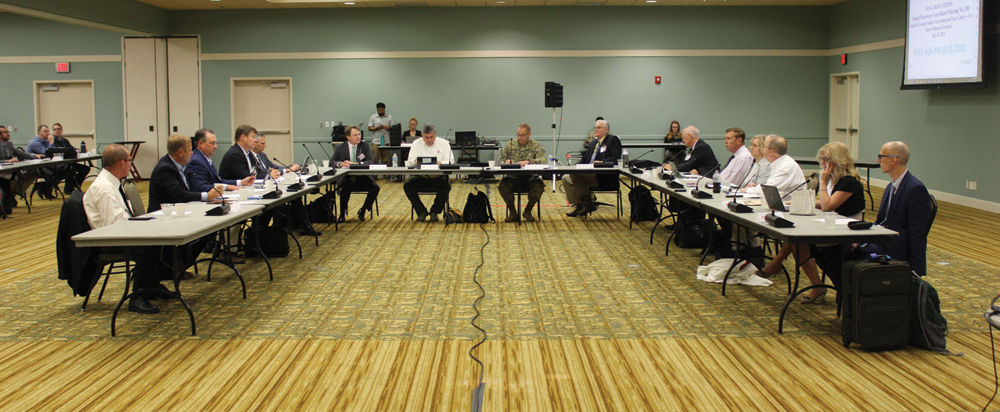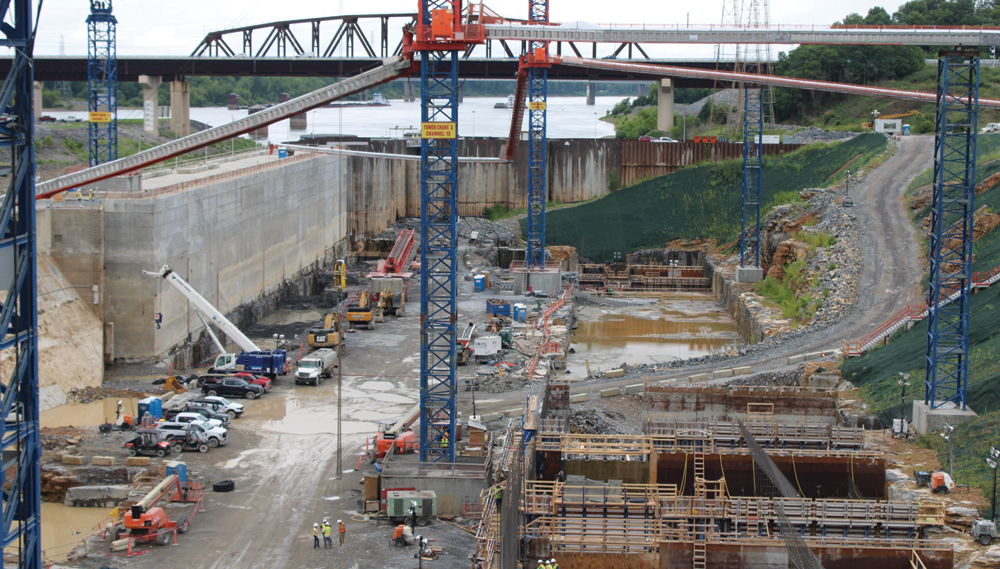During the July 20 meeting of the Inland Waterways Users Board (IWUB) in Paducah, Ky., the board voted unanimously to recommend that the remaining cost for several major lock construction and rehabilitation projects be funded entirely by the federal government and not the Inland Waterways Trust Fund (IWTF). The projects in question include those at Montgomery Locks and Dam, the Three Rivers project on the McClellan–Kerr Arkansas River Navigation System, Upper Mississippi Lock and Dam 25 and the major rehabilitation of T.J. O’Brien Lock and Dam on the Calumet River. All of the projects were included as part of the Infrastructure Investment and Jobs Act (IIJA) at a level that was believed to fund them to completion. However, updated cost certifications from the Corps of Engineers show they will now cost significantly more.
IWUB Chairman Spencer Murphy made the motion for the cost overruns to be 100 percent funded by the government with no cost-share split from the trust fund, with board member Martin Hettel seconding. Board member Dennis Oakley asked if the vote could hold up any ongoing work, with Hettel commenting that he didn’t see how the increased costs could be covered without significant delays to other projects unless Congress paid for them. All eventually voted “aye” on the motion.

The IWUB does not have final say on how the projects are funded, however. Instead, the group is an advisory board established to monitor the Inland Waterways Trust Fund and to make recommendations to the Army and to Congress on investment priorities to support inland navigation infrastructure needs using resources from the fund. Generally, construction and major rehabilitation on inland navigation projects are cost-shared 65 percent by the federal government and 35 percent by the IWTF, which generates its revenues from a 29-cent tax on marine diesel fuel sales for inland commercial vessels.
In an update from Mark Pointon, the IWUB’s executive secretary and designated federal officer, the board learned that the starting balance in the Inland Waterways Trust Fund this year was roughly $200.5 million. Fuel tax revenue of $67.4 million had been received as of May 10, and an additional update is expected in August or September from the Internal Revenue Service. About $25 million was reported transferred in June, with about $10 million of that going to the Upper Mississippi Project, about $9 million for the Chickamauga Lock Replacement Project and about $5 million for the Lower Monongahela Project as the largest projects receiving money from the fund. Pointon said he expects to provide the board with regular updates on the fund moving forward.
The board also heard updates on several major projects throughout the inland waterways system, including recently released cost increase estimates for both the Montgomery and Three Rivers projects, both of which were formerly believed to be funded to completion under IIJA. A day before the meeting, on July 19, the board toured the Kentucky Lock Addition Project, 22 miles upstream from Paducah on the Tennessee River, where construction is nearing the half-way point.
Kentucky Lock Addition Project
The Kentucky Lock project, which adds a 1,200-foot by 110-foot navigational lock chamber beside the existing 600-foot chamber, is now approximately 45 percent complete, project manager Bob Winters told The Waterways Journal.
Thalle Construction is building the $380 million downstream lock monoliths as part of the current contract. That work is estimated to be completed in May 2027. Future work at the lock includes installation of the approach walls, electrical and mechanical work, building construction, bridge construction, movement of utilities and site development. The Nashville Engineer District forecasts the new lock chamber to be operational in 2029-2030 and the overall project to be completed in 2031.
In April 2022, the IWUB learned the project’s cost had ballooned. While previously the $465,492,000 included in IIJA was expected to fund it to completion, the certified cost estimate completed that month indicated an additional $332 million was required. That brought the total project cost estimation to $1,561,073,000.
Upper Ohio Navigation Project
Christopher Dening, program manager for mega projects for the Upper Ohio River Locks and Dams for the Pittsburgh Engineer District, updated the board about ongoing work on the Upper Ohio.
The project involves three locks and dams on the Ohio River: Emsworth (Mile 6.2), Dashields (Mile 13.3) and Montgomery (Mile 13.7). Existing 360- by 56-foot auxiliary lock chambers will be replaced with new 600- by 110-foot chambers—the same size as existing main chambers—at each.
The project schedule calls for design at Montgomery to continue through the end of this year and for a contract for the new riverside chamber to be awarded toward the end of 2024, Dening said. Design at Emsworth has begun and is to continue through 2025. Construction at Emsworth is scheduled to take place from 2032-2042. Design at Dashields is to take place 2025-2027 with construction there anticipated for 2043-2051.
The work at Montgomery is on schedule, but Dening informed the IWUB that the new certified project cost for Montgomery was completed June 16 and is now roughly $1.7 billion, which includes a “sizeable contingency” to cover market uncertainty and inflation. That is an addition of nearly $513 million to the total cost at Montgomery.
“My goodness,” Hettel said. “This project has more than doubled in cost since it received the IIJA funding. What is driving this?”
Dening said the major drivers were inflation and the contingency to account for possible future inflation.
Dening said he anticipates needing more funding to complete the work at Dashields and Emsworth. However, he said, the $77 million received so far should make it possible to complete the design work, real estate acquisition and small portions of construction at Emsworth.
Hettel asked if the value engineering study completed in 2018 had provided any more ideas that could reduce costs. Dening said no, although he noted that study had previously resulted in the change from “in the wet” to “in the dry construction,” which did result in savings.
Dening said the Corps’ goal is to obtain a new certified cost analysis on Emsworth and Dashields by the end of the calendar year.
Three Rivers Project On MKARNS
Work on the second phase of the Three Rivers construction project is delayed due to lack of funding, while the first phase is behind schedule, said Jonathan Gilip, project manager for the Three Rivers Project on the McClellen-Kerr Arkansas Navigation System (MKARNS) for the Little Rock Engineer District.
The value for the Phase 1 design-build contract, awarded in July 2022, was $175.85 million. That phase is scheduled to be completed in September 2026 and is behind about five months because of the timing of a protest that caused crews to miss the dry season. Notice to proceed was not received until January 5. Design is complete to the 65 percent level, Gilip said in his presentation. A groundbreaking ceremony is anticipated next month for both cofferdam and mooring areas of the project.
The Phase 2 contract cannot be awarded without an increase in funding, Gilip said. While Phase 2 was authorized to proceed for a cost of up to $279.49 million, the certified cost estimate completed in December 2022 came in at a fully-funded cost of $355.68 million.
Navigation And Ecosystem Sustainability Program
Jose Lopez, program manager for Upper Mississippi Lock and Dam 25 for the St. Louis Engineer District, said that a certified cost analysis is ongoing for the construction of a new 1,200-foot lock at Lock and Dam 25. It is considered procurement sensitive information due to the project being completed via a contract that uses early contractor involvement so will not be released publicly at this time, he said.
Lock and Dam 25 is the first lock and dam to receive improvements as part of the Navigation and Ecosystem Sustainability Program (NESP) on the Upper Mississippi River and Illinois Waterway. The first construction appropriations for the project were for $732 million for NESP as a whole, via the IIJA. No cost for the work at Lock and Dam 25 was available individually, Lopez said. The Corps released a 15 percent design contract for the work June 9 and hosted a pre-bid site visit with contractors June 29. The design phase of the project is expected to be complete in 2026.
Phase 1 of the lock wall construction contract, a $10.1 million firm, fixed-price contract, was awarded September 6, with construction expected to be complete in December of this year. The new lock is scheduled to be operational in October 2034 with completion in 2036.
Chickamauga Lock Replacement
Although not funded by IIJA, the projected cost for the Chickamauga Lock Replacement Project has also increased, said Elizabeth Burks, chief of the integrated project office for the Nashville Engineer District, which oversees both the Kentucky and Chickamauga projects.
The project involves the construction of a new 110-foot by 600-foot lock on the Tennessee River at Mile 471 in Chattanooga, Tenn., necessary because of alkali aggregate reaction threatening the stability and operability of the existing lock. The project is 45 percent complete, with $426 million expended to date, Burks said.
The certified cost for the new lock as of March 16 is $954.4 million, Burks said. The total project cost increased by $197.5 million, or 26 percent.
Additionally, roughly 2.5 years has been added to the lock operation date and three years for the final completion date. The contractor is significantly behind, and efforts to regain the schedule to achieve the required contract completion date of November 10, 2023, have not been successful, Burks said. The new lock operational date is November 2026.
A lock chamber certified claim alleges cost and schedule impacts due to a variety of items, most notably COVID-19, Burks said. A review of the claim is planned for February 2024.
Lower Monongahela
James Shibata, chief of the programs and project management branch for the Pittsburgh Engineer District, gave an update on the projects at locks 2, 3 and 4 on the Monongahela River.
Work on the fixed crest dam at Lock and Dam 2 at Braddock has already been completed. The new, expanded riverside lock chamber at Lock and Dam 4 at Charleroi should be fully operational in January 2024 with the full contract complete in July 2024, he said. Upon the river chamber being fully operational, the landside chamber is slated to close. It will not be operational once Lock and Dam 3 at Elizabeth is removed in favor of a navigable pass, creating one, 30.3-mile pool instead of separate 12.3- and 18-mile pools.
Bids were opened earlier this month for the removal at Elizabeth, and the contract is expected to be awarded in August, Shibata said. Dam removal is scheduled to begin in July of next year and to be complete by the end of 2024.
A PowerPoint presentation showed issues and challenges with the work include that funding awarded in fiscal year 2020, which was supposed to have completed the work at Charlerloi, is sufficient to reach the 90 percent benefits level but insufficient to complete the remaining work, Shibata said. He added that he hopes to have a new cost certification for the project by the end of this year.



